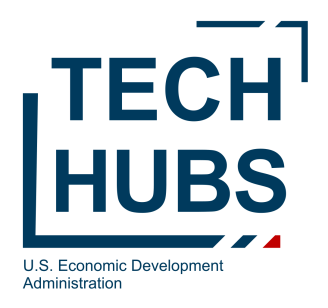Archived Content
This site contains information that has been considered archived and will no longer be updated.
Tech Hubs Aim to Make United States the Global Leader in Technologies of the Future. A Conversation with Eric Smith
Eric Smith is the Tech Hubs Program Director at the U.S. Department of Commerce’s Economic Development Administration (EDA). We sat down with him to discuss Tech Hubs, what it’s all about, and how the program is an investment in America’s people, places and potential.
Q&A Interview
Question: You are the Tech Hubs program’s inaugural director. What gets you excited about the program and your new role?
Eric:

Technology-driven development is critical to our strategy of strengthening U.S. economic and national security. That mission—to enable the industries of the future to start, grow, and remain in the United States—is compelling and energizing. There’s an urgency to ensuring we maintain and grow our global leadership in technology innovation, and it’s essential that the economic benefits of our leadership accrue to everyone equitably.
Aside from designing and implementing Tech Hubs, I also see the program as an important turning point in EDA’s ongoing evolution. For EDA’s first 45 or so years, we primarily had one, albeit important, tool—our Public Works & Economic Adjustment Assistance (PWEAA) suite of programs. Over the past decade, Congress expanded that toolbox with innovation-focused programs like Build to Scale and the STEM Talent Challenge and has tasked EDA with deploying more and larger investments. Tech Hubs builds off the success of these programs and investments and gives us the ability to concentrate and coordinate investments so that regions will marshal their resources and networks around one cohesive goal—catalyzing technology- and innovation-centric growth to become globally competitive.
Question: What does it mean for a region to be globally competitive in a specific technology? As these newly Designated Hubs compete for EDA investment of ~$50-$75M, what are they really looking to unlock that for their regions?
Eric:
The Tech Hubs made their cases for why they have the foundations for global competitiveness; in Phase 2, they’ll propose how they’ll achieve that. In Phase 2, we will invest in regions that have strong potential to lead globally across a wide array of critical and emerging technologies and the people and places that make and deliver these products and services.
In most successful Hubs, we’re going to see these regions—and the industries within them—build and gain market share in particular industries. We also expect to see markers of increased innovation, increased business creation and expansion, and increased investment in these places. We’re looking for market potential—where are there viable commercialization paths for these critical technologies? What regions are building effective interfaces between their engines of innovation and industry that will make them globally competitive and that will result in new, good jobs? We’ll ask these Hubs and ourselves these questions repeatedly as the Hubs put together their Phase 2 project proposals and as we evaluate them.
As to the investments we’ll make in Phase 2, they’ll fund projects that strengthen the economic infrastructure on which regions grow—e.g., that build workforce and attract talent, that increase the flow of capital, that support businesses starting and growing, that facilitate testing and deploying technologies. Each hub will have its own mix of projects, tailored to their specific opportunities.
"We’re looking for market potential—where are there viable commercialization paths for these critical technologies?"
Name association between a place and a technology is the epitome of competitiveness. We all know the places that are existing hubs. Our goal is to enable the Tech Hubs that we designate and fund to capture more of their focus industry’s market share globally. These investments inject regions with an extra boost to generate more innovation, more services, more products, and more sales in a particular technology area. And, one day, they may also become a new place that’s synonymous with their particular technology.
Question: Tech Hubs is part of the Chips and Science Act. The program was authorized at $10 billion, however, EDA only received $500 million in appropriated funding. This is another EDA investment tool that calls for and prioritizes growth and development based on locally-driven solutions to locally-identified challenges. And EDA isn’t the only part of the federal government implementing this strategy. Why is this approach important?
Eric:

Long-term growth needs buy-in from those on the ground. People, places, and organizations are complex, and success requires intentionality and ownership by the local leaders responsible for its execution. Building regional technology and innovation hubs requires federal and local government, research institutions, industry, workforce, labor, community organizations, and other partners to come together and coalesce around a shared strategy. The consortium model also allows for more effective governance by providing structure and a forum to enable real and durable collaboration.
The Tech Hubs program challenges organizations in these regions to come together to identify market failures and other opportunities that can’t or won’t be addressed by a single person or institution. By pursuing EDA investment, regions not only can organize to seize those opportunities but also—and, sometimes, more importantly—can help regions attract a flood of additional capital tailored to each of those opportunities and capable of ratcheting the region’s growth up to another level.
Question: How is Tech Hubs different from other place-based programs that we have seen?
Eric:
Tech Hubs isn’t starting from scratch. We are targeting regions with mature ecosystems with mature assets and resources, and asking: What can EDA build on to take this region from excellent to globally competitive?
“Designation and EDA’s investments should be seen as a signal to the broader capital community of these regions’ potential to generate a return in both dollars and impact.”
We are also asking for a regional commitment to a strategy. The entire consortium of regional organizations—from lab to customer—need to be part of this strategy and have a stake in the game.
Question: Equity has become a center piece of EDA's investments under the current administration. In real terms, how is Tech Hubs advancing equity and broadening economic growth opportunities?
Eric:
Economic and national security are closely tied. Creating more centers of technology-driven economic development across the country and ensuring opportunity and inclusion in that growth will help us realize the program’s vision. Growth needs to benefit the people and workers who live in these hubs, as well as the companies and institutions within and connected to these regions.
For that to happen, the leadership of these Hubs must include people who represent and come from the diverse communities within their regions. We’ve deliberately built this into the program. When we’re looking at a Hub’s governance and leadership, we’re looking for strength and durability because these are long-term strategies that take collaboration and shared commitment to successfully execute. To enable that, Hubs need to build and maintain inclusive leadership teams that will continue to pursue equity as these regional innovation economies grow over the coming years and decades.
Also, Tech Hubs is adopting a data-driven approach to baseline current economic activity to measure and better understand the impacts of EDA’s investments on overall changes in economic activity and who benefits from it.
With policy interventions and direct investments in talent and workforce development, we believe Tech Hubs can have tangible impacts on improving people’s lives. We are working to upskill a region’s workforce so that residents may fully participate in its evolving economy and support the development of these critical technologies that are fundamental to these regions’ and our country’s economic success. We are taking concrete steps—as you can see in how we’ve designed our funding criteria and in what we’re requiring and encouraging regions to incorporate into their plans and projects—to help ensure economic growth is inclusive, such as securing local hiring commitments for quality jobs and accounting for significant economic and population growth in long-term housing and transportation plans.
Question: What are the ingredients of successful Tech Hubs?
Eric:
Each region has unique challenges and opportunities due to factors like their specific assets, resources, and capabilities and the core technology area in which they’re pursuing global competitiveness. Tech Hubs is designed to work with regional consortia to identify and overcome barriers to commercially scaling critical innovation and technology development globally.
All Tech Hubs, however, hold the promise of becoming leaders not just in innovation but also production and delivery within a given technology area—the promise of inclusive economic success. This promise sits at the confluence of innovation, resources, and technical expertise. We’re looking for regions that have this foundation and a track record of regional collaboration within their technology innovation ecosystem.
Tech Hubs will be an active co-investor in these ecosystems. Designation and EDA’s investments should be seen as a signal to the broader capital community of these regions’ potential to generate a return in both dollars and impact.
